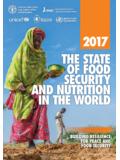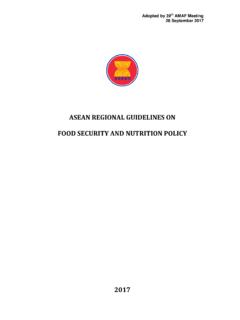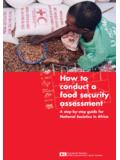Transcription of WHO EUROPEAN POLICY 2007-2012
1 WHO EUROPEAN ACTION PLAN FOR food AND NUTRITIONPOLICY 2007 - 2012 KEYWORDS nutrition POLICYFOOD SUPPLYFOODBORNE CONTAMINATION - PREVENTION AND CONTROLFOOD POISONINGOBESITY - PREVENTION AND CONTROLSAFETY MANAGEMENTREGIONAL HEALTH PLANNINGEUROPEA ddress requests about publications of the WHO Regional Office for Europe to: Publications WHO Regional Office for Europe Scherfigsvej 8 DK-2100 Copenhagen , DenmarkAlternatively, complete an online request form for documentation, health information, or for permission to quote or translate, on the Regional Office web site ( ). World Health Organization 2008 All rights reserved. The Regional Office for Europe of the World Health Organization welcomes requests for permission to reproduce or translate its publications, in part or in designations employed and the presentation of the material in this publication do not imply the expression of any opinion whatsoever on the part of the World Health Organization concerning the legal status of any country, territory, city or area or of its authorities, or concerning the delimitation of its frontiers or boundaries.
2 Dotted lines on maps represent approximate border lines for which there may not yet be full mention of specific companies or of certain manufacturers products does not imply that they are endorsed or recommended by the World Health Organization in preference to others of a similar nature that are not mentioned. Errors and omissions excepted, the names of proprietary products are distinguished by initial capital reasonable precautions have been taken by the World Health Organization to verify the information contained in this publication. However, the published material is being distributed without warranty of any kind, either express or implied.
3 The responsibility for the interpretation and use of the material lies with the reader. In no event shall the World Health Organization be liable for damages arising from its use. The views expressed by authors, editors, or expert groups do not necessarily represent the decisions or the stated POLICY of the World Health almost all Member States in the EUROPEAN Region have government-approved policies on nutri-tion and food safety, the burden of disease associated with poor nutrition continues to grow in the Euro-pean Region, particularly as a result of the obesity epidemic, while foodborne diseases still represent a challenge for EUROPEAN health developments over the past few years indicate how to strategically adapt and renew the First Action Plan for food and nutrition POLICY .
4 This Second Action Plan establishes health, nutrition , food safety and food security goals and provides a coherent set of integrated actions, spanning different government sec-tors and involving public and private actors, for Member States to consider in their own national policies and health system governance and for international organizations to consider at the regional and global actions include improving nutrition and food safety in early life, ensuring a safe, healthy and sus-tainable food supply, providing comprehensive information and education to consumers, integrating ac-tions to address related determinants (such as physical activity, alcohol, water, environment), strengthen-ing nutrition and food safety in the health sector, and monitoring and evaluating progress and WHO Regional Office for Europe commits to support the implementation of the Second Action Plan by raising awareness and promoting political commitment to address food - and nutrition -related health and health system challenges in Member States, and at the EUROPEAN and global levels.
5 Providing techni-cal support for food and nutrition POLICY development, POLICY analysis and capacity building to Member States in the context of their specific health systems; monitoring the public health nutrition and food safety situation, assessing trends and reporting on implementation; and establishing synergies and integrating action within health systems governance on related public health services and strategies (such as physical activity promotion, alcohol consumption, noncommunicable and communicable disease prevention, and water safety).In September 2007 , the WHO Regional Committee for Europe approved resolution EUR/RC57/R4, which endorses the Action Plan and calls on Member States to develop and implement food and nutrition policies.
6 CONTENTSPageBackground ..1 Strategic framework ..3 Goals and targets ..4 Action areas ..4 Action area 1 Supporting a healthy start ..5 Action area 2 Ensuring a safe, healthy and sustainable food supply ..7 Action area 3 Providing comprehensive information and education to consumers ..10 Action area 4 Taking integrated action to address related determinants ..12 Action area 5 Strengthening nutrition and food safety in the health sector ..14 Action area 6 Monitoring, evaluation and research ..16 The actors ..19 Governments ..19 Civil society and professional networks ..20 Economic operators ..20 International actors.
7 21 Steps for implementation ..23 Implementation in countries ..23 The role of WHO ..25 References ..2711. In September 2000, the WHO Regional Com-mittee for Europe endorsed the First Action Plan for food and nutrition POLICY for the WHO Euro-pean Region, 2000 2005 (1), calling for the de-velopment of food and nutrition policies in Member States. Since then, one third of the Member States in the WHO EUROPEAN Region have developed poli-cies on food and nutrition , and almost all now have government-approved documents dealing with nutrition and food safety (2). However, in the ma-jority of countries in the Region, nutrition -related and foodborne diseases still represent a consider-able public health burden.
8 Several countries have started to develop national policies and action plans that specifically address physical activity and aim to build greater capacity for physical ac-tivity In 2002, poor nutrition accounted for of the total disease burden in the Region (measured in disability-adjusted life-years, or DALYs). Acute undernutrition is still documented in areas facing food insecurity, and chronic undernutrition due to micronutrient deficiencies extensively affects vul-nerable populations. Undernutrition in the elderly, in chronically ill patients and in disabled individuals is present to a variable extent throughout the Re-gion.
9 Obesity, a rapidly growing challenge that has now reached epidemic proportions, accounts for an additional 7 8% of DALYs suffered, while more than two thirds of the population is not engaged in sufficient physical activity, contributing a further of DALYs suffered (3,4). Micronutrient de-ficiencies are also a concern for the Region, and the rate of exclusive breastfeeding at six months is low everywhere (ranging from 1% to 46%), even in countries with high initiation rates (5).BACKgROUND3. Foodborne diseases, particularly those of zoonotic origin, represent a considerable public health burden and challenge.
10 Salmonellosis and campylobacteriosis are the most commonly re-ported foodborne diseases. In some parts of the Region, the occurrence of foodborne diseases such as brucellosis and botulism is a significant public health problem; zoonotic parasitic diseases such as trichinellosis and echinococcosis are of particu-lar concern. Antimicrobial resistance is an increas-ing public health problem, which is partly related to non-human usage of antimicrobial agents (6). Various chemical hazards also represent a public health risk and food allergies are increasingly rec-ognized as a In low-income countries in the Region, poverty affects more than half the population, leading to food insecurity and the consumption of unsafe foods of poor nutritional quality.














